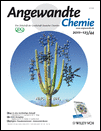Oxidative Addition von BF3 an ein Übergangsmetall†
Jürgen Bauer
Institut für Anorganische Chemie, Julius-Maximilians-Universität Würzburg, Am Hubland, 97074 Würzburg (Deutschland)
Search for more papers by this authorCorresponding Author
Prof. Dr. Holger Braunschweig
Institut für Anorganische Chemie, Julius-Maximilians-Universität Würzburg, Am Hubland, 97074 Würzburg (Deutschland)
Institut für Anorganische Chemie, Julius-Maximilians-Universität Würzburg, Am Hubland, 97074 Würzburg (Deutschland)Search for more papers by this authorDr. Katharina Kraft
Institut für Anorganische Chemie, Julius-Maximilians-Universität Würzburg, Am Hubland, 97074 Würzburg (Deutschland)
Search for more papers by this authorDr. Krzysztof Radacki
Institut für Anorganische Chemie, Julius-Maximilians-Universität Würzburg, Am Hubland, 97074 Würzburg (Deutschland)
Search for more papers by this authorJürgen Bauer
Institut für Anorganische Chemie, Julius-Maximilians-Universität Würzburg, Am Hubland, 97074 Würzburg (Deutschland)
Search for more papers by this authorCorresponding Author
Prof. Dr. Holger Braunschweig
Institut für Anorganische Chemie, Julius-Maximilians-Universität Würzburg, Am Hubland, 97074 Würzburg (Deutschland)
Institut für Anorganische Chemie, Julius-Maximilians-Universität Würzburg, Am Hubland, 97074 Würzburg (Deutschland)Search for more papers by this authorDr. Katharina Kraft
Institut für Anorganische Chemie, Julius-Maximilians-Universität Würzburg, Am Hubland, 97074 Würzburg (Deutschland)
Search for more papers by this authorDr. Krzysztof Radacki
Institut für Anorganische Chemie, Julius-Maximilians-Universität Würzburg, Am Hubland, 97074 Würzburg (Deutschland)
Search for more papers by this authorWir danken der Deutschen Forschungsgemeinschaft (DFG) für finanzielle Unterstützung. J.B. dankt dem Fonds der Chemischen Industrie für ein Doktorandenstipendium.
Graphical Abstract
Bortrifluorid wird durch oxidative Addition an den Übergangsmetallkomplex [(Cy3P)2Pt] aktiviert. Das Produkt dieser Addition, trans-[(Cy3P)2Pt(BF2)(FBF3)], wurde durch NMR-Spektroskopie und Röntgenstrukturanalyse charakterisiert. Weiterhin wurden das Zersetzungsprodukt trans-[(Cy3P)2Pt(H)(FBF3)] sowie das stabile Derivat [(Cy3P)2Pt(BF2)(Cl)] vollständig charakterisiert.
Supporting Information
Detailed facts of importance to specialist readers are published as ”Supporting Information”. Such documents are peer-reviewed, but not copy-edited or typeset. They are made available as submitted by the authors.
| Filename | Description |
|---|---|
| ange_201103226_sm_miscellaneous_information.pdf508.6 KB | miscellaneous_information |
Please note: The publisher is not responsible for the content or functionality of any supporting information supplied by the authors. Any queries (other than missing content) should be directed to the corresponding author for the article.
References
- 1P. S. Baran, T. J. Maimone, J. M. Richter, Nature 2007, 446, 404–408.
- 2R. W. Hoffmann, Synthesis 2006, 3531–3541.
- 3J. A. Labinger, J. E. Bercaw, Nature 2002, 417, 507–514.
- 4J. F. Young, J. A. Osborn, F. H. Jardine, G. Wilkinson, J. Chem. Soc. Chem. Commun. 1965, 131–132.
- 5C. S. Cundy, B. M. Kingston, M. F. Lappert, Adv. Organomet. Chem. 1973, 11, 253–330.
- 6D. Männig, H. Nöth, Angew. Chem. 1985, 97, 854–855;
10.1002/ange.19850971009 Google ScholarAngew. Chem. Int. Ed. Engl. 1985, 24, 878–879.
- 7M. Gozin, A. Weisman, Y. Ben David, D. Milstein, Nature 1993, 364, 699–701.
- 8J. Burdeniuc, B. Jedlicka, R. H. Crabtree, Chem. Ber./Recl. 1997, 130, 145–154.
- 9M. Aizenberg, D. Milstein, Science 1994, 265, 359–361.
- 10G. A. Molander, S. L. J. Trice, S. D. Dreher, J. Am. Chem. Soc. 2010, 132, 17701–17703.
- 11
- 11aH. Braunschweig, K. Gruss, K. Radacki, Angew. Chem. 2007, 119, 7929–7931; Angew. Chem. Int. Ed. 2007, 46, 7782–7784;
- 11bH. Braunschweig, K. Gruss, K. Radacki, Inorg. Chem. 2008, 47, 8595–8597;
- 11cH. Braunschweig, K. Gruss, K. Radacki, Angew. Chem. 2009, 121, 4303–4305; Angew. Chem. Int. Ed. 2009, 48, 4239–4241;
- 11dJ. Bauer, H. Braunschweig, P. Brenner, K. Kraft, K. Radacki, K. Schwab, Chem. Eur. J. 2010, 16, 11985–11992.
- 12
- 12aH. Braunschweig, K. Radacki, D. Rais, D. Scheschkewitz, Angew. Chem. 2005, 117, 5796–5799; Angew. Chem. Int. Ed. 2005, 44, 5651–5654;
- 12bH. Braunschweig, K. Radacki, D. Rais, F. Seeler, Organometallics 2004, 23, 5545–5549;
- 12cH. Braunschweig, P. Brenner, A. Mueller, K. Radacki, D. Rais, K. Uttinger, Chem. Eur. J. 2007, 13, 7171–7176;
- 12dH. Braunschweig, M. Fuss, K. Radacki, K. Uttinger, Z. Anorg. Allg. Chem. 2009, 635, 208–210.
- 13N. Lu, N. C. Norman, A. G. Orpen, M. J. Quayle, P. L. Timms, G. R. Whittell, Dalton 2000, 4032–4037.
- 14H. Braunschweig, K. Radacki, K. Uttinger, Chem. Eur. J. 2008, 14, 7858–7866.
- 15N. A. Jasim, R. N. Perutz, J. Am. Chem. Soc. 2000, 122, 8685–8693.
- 16M. E. Jacox, K. K. Irikura, W. E. Thompson, J. Chem. Phys. 2000, 113, 5705–5715.
- 17D. Mootz, M. Steffen, Z. Anorg. Allg. Chem. 1981, 483, 171–180.
- 18T. H. Peterson, J. T. Golden, R. G. Bergman, Organometallics 1999, 18, 2005–2020.
- 19
- 19aD. L. Kays (née Coombs), A. Rossin, J. K. Day, L. Ooi, S. Aldridge, Dalton Trans. 2006, 399–410;
- 19bD. Vidovic, S. Aldridge, Angew. Chem. 2009, 121, 3723–3726;
10.1002/ange.200901022 Google ScholarAngew. Chem. Int. Ed. 2009, 48, 3669–3672.
- 20H. Braunschweig, R. Leech, D. Rais, K. Radacki, K. Uttinger, Organometallics 2008, 27, 418–422.
- 21E. S. Chernyshova, R. Goddard, K. R. Poerschke, Organometallics 2007, 26, 3236–3251.
- 22J. Zhu, Z. Lin, T. B. Marder, Inorg. Chem. 2005, 44, 9384–9390.
Citing Literature
This is the
German version
of Angewandte Chemie.
Note for articles published since 1962:
Do not cite this version alone.
Take me to the International Edition version with citable page numbers, DOI, and citation export.
We apologize for the inconvenience.





